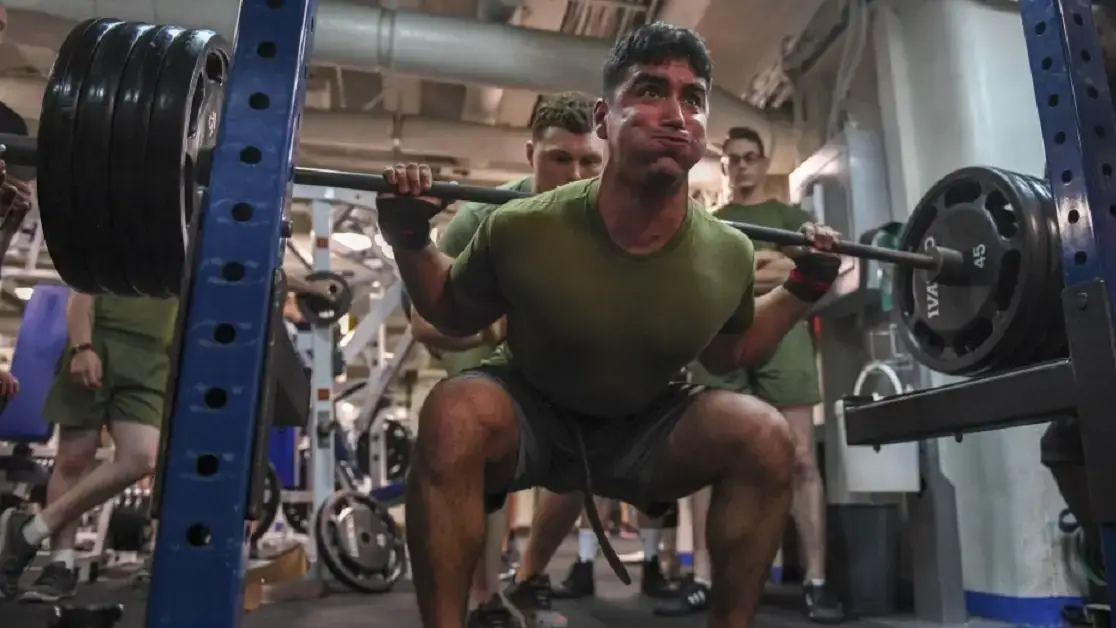Fighter pilots are lifting heavy. Why don’t you?

SUMMARY
Breathe and brace, lift, exhale. That's it, pretty freakin' simple. Why then do so many people literally forget how to breathe when lifting heavy? It's involuntary. You would die without sweet, sweet oxygen pouring into your face holes constantly. When you are about to squat 2x your body weight, or even just your body weight, the number one risk to injury is structural damage, be that muscular or skeletal. The most efficient way to prevent injury from occurring is to brace and contract all non-moving body parts. It's called the Valsalva maneuver. But first...

Other approaches to breathing
Common other breathing methods such as exhaling on the concentric and inhale on the eccentric are problematic for lifting heavy weights.
In order to inhale or exhale, we need to engage the diaphragm and other breathing muscles to draw in air or release it. This means that the body needs to do two separate things while lifting; breath and lift.
This is problematic for a few reasons.
(U.S. Marine Corps photo by Lance Cpl. Sarah N. Petrock)
- Most people aren't coordinated enough to successfully do this for every rep of every set at the proper cadence.
- With two different processes going on, you aren't able to actually recruit the maximum amount of muscle possible.
- If certain muscles of the core aren't fully contracted, they are at higher risk for injury during the movement. This is a bit of a domino effect, especially if you tend to breathe into your shoulders or belly. Some of those muscles that should be used for the lift may end up sitting the rep out from confusion as to what they should be doing exactly.
- If something in your form goes awry, a muscle that isn't "paying attention" to the lift may jump in at the wrong moment and get pulled. This happens with muscles between the ribs often.

How to breathe
Think back to the last time you picked up or pushed something heavy. What did you naturally do?
You breathed and braced.
This technique, called the Valsalva maneuver, has been used by fighter pilots, SCUBA divers, lifters, and doctors for hundreds of years with little to no complications.
It doesn't matter if you're picking up a torpedo, a mortar plate, a tire, or your overweight nephew. They all elicit the same involuntary response… the breathe and brace Valsalva maneuver.
Here's how you do it:

1. Inhale
A deep inhale fills your core and increases pressure like in an unopened carbonated beverage rather than a plastic water bottle that is ¾ empty.
Fully filled lungs are step one towards the ideal apparatus for transferring power from your legs and ass to the barbell you're attempting to move in all heavy lifts.

2. Flex your abs
In the squat, for instance, this means isometrically contracting all of your core muscles to support the spine and those muscles themselves.
By staying tight, you are putting yourself "on the rails" there is literally no wiggle room for your form to get jacked up.
Once ALL of your core muscles are contracted, you can take total advantage of maximum abdominal pressure.
With the core muscles contracted, there is no longer space in the abdomen that needs to be occupied. We have now removed all possibility of unwanted movement in the spine and core.

3. Execute the rep
Perform the rep in its entirety until you are back to the starting position. Check out these other articles for specifics on perfect form for the main lifts.
- The complete bench press checklist
- 5 steps to back squat perfection
- 5 steps to deadlift perfection
(U.S. Navy photo by Mass Communication Specialist 3rd Class Roland John)
4. Exhale and repeat
Lift using the Valsalva maneuver to protect your spine and allow for the maximal transfer of force in whatever movement you are doing.
When you are doing lighter exercises or the big exercises at lighter weight the Valsalva isn't necessary. You can, in these cases use the other method described above. The Valsalva is the big gun that you bring out when you make it to the final boss level. Generally, it's only needed for your main lifts for each workout like squats, deadlifts, and the bench press.

What about blood pressure?
Yes, your blood pressure does increase when you perform the Valsalva. No there is not no risk to the technique (that's a double negative).
Listen to the above video for why and how you don't need to worry as long as you are otherwise healthy.
In addition, here is a very in-depth source on the intricacies of blood pressure and the Valsalva maneuver.
If you aren't otherwise healthy, you shouldn't be training at all without your doctor's approval. This discussion is no exception.
Breathe smartly my friends.
SHARE
